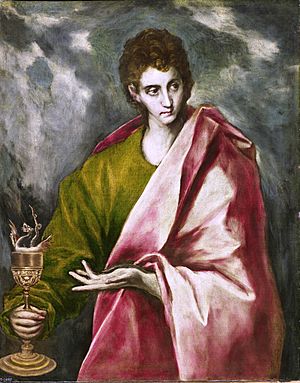Sehet, welch eine Liebe hat uns der Vater erzeiget, BWV 64 facts for kids
Quick facts for kids Sehet, welch eine Liebe hat uns der Vater erzeiget |
|
|---|---|
| Christmas cantata | |

John the Evangelist, celebrated on 27 December
|
|
| Occasion | Third Day of Christmas |
| Performed | 27 December 1723: Leipzig |
| Movements | 8 |
| Vocal | |
| Instrumental |
|
Sehet, welch eine Liebe hat uns der Vater erzeiget (which means "Behold, what a love has the Father shown to us"), also known as BWV 64, is a special piece of music called a church cantata. It was written by the famous composer Johann Sebastian Bach. He created this Christmas cantata in Leipzig, Germany, in 1723.
Bach wrote it for the third day of Christmas, which is also a special day to remember John the Evangelist. The very first time this music was performed was on December 27, 1723.
Contents
About This Music
When and Why It Was Written
Bach wrote this cantata during his first year working as the Thomaskantor in Leipzig. This was part of his first big collection of cantatas. He wrote it specifically for the Third Day of Christmas.
On this day, churches would read certain parts of the Bible. These included passages from the Epistle to the Hebrews (about Christ being greater than angels) and the Gospel of John (about "the Word"). The person who wrote the words for this cantata focused on how much God loves us, especially at Christmas. This love means believers don't need to worry about the "world" anymore.
Special Chorales
This cantata is special because it includes three chorales. A chorale is like a hymn or a church song that everyone can sing. It was not common for Bach to include so many chorales in one cantata.
The first part of the cantata uses words from the Bible, specifically from 1 John 3:1. The second part uses a Christmas chorale called "Gelobet seist du, Jesu Christ". Another part, movement 4, uses the first verse of "Was frag ich nach der Welt". The cantata ends with "Gute Nacht, o Wesen", which is part of the chorale "Jesu, meine Freude".
Instruments and Voices
What You Hear
This cantata is performed by several different voices and instruments.
- Singers: There are solo singers (a soprano, an alto, and a bass). There's also a four-part choir, which means a group of singers with soprano, alto, tenor, and bass voices.
- Instruments: The instruments include a zink (an old wind instrument), three trombones, an oboe d'amore (a type of oboe), two violins, a viola, and a basso continuo. The basso continuo is a group of instruments that play the bass line and harmonies, like a cello and a keyboard instrument.
How It's Organized
The cantata has eight different parts, called movements:
- Chorus: Sehet, welch eine Liebe hat uns der Vater erzeiget (A big song for the choir)
- Chorale: Das hat er alles uns getan (A hymn-like song)
- Recitative (alto): Geh, Welt, behalte nur das Deine (A part where the alto singer "sings" in a speech-like way)
- Chorale: Was frag ich nach der Welt (Another hymn-like song)
- Aria (soprano): Was die Welt in sich hält (A beautiful song for the soprano soloist)
- Recitative (bass): Der Himmel bleibet mir gewiß (A speech-like part for the bass singer)
- Aria (alto): Von der Welt verlang ich nichts (A beautiful song for the alto soloist)
- Chorale: Gute Nacht, o Wesen (The final hymn-like song)
The Music Itself
The first part, the opening chorus, sounds very old-fashioned, like a motet. The trombones play along with the singers, making the sound even richer. In the alto recitative, the continuo instruments play strong, fast notes.
The soprano aria is like a dance called a Gavotte. A solo violin plays very fast and skillfully, perhaps showing how busy "worldly things" can be. The alto aria is gentle and melodic, with the oboe d'amore playing a beautiful tune. The last chorale, "Gute Nacht, o Wesen", is sung by all four voice parts.
Recordings
You can listen to this cantata on these recordings:
- Bach Cantatas Vol. 1 – Advent and Christmas, conducted by Karl Richter, 1972
- Die Bach Kantate Vol. 63, conducted by Helmuth Rilling, 1981
- J. S. Bach: Complete Cantatas Vol. 8, conducted by Ton Koopman, 1998
- J. S. Bach: Cantatas Vol. 13, conducted by Masaaki Suzuki, 1999
- Bach Cantatas Vol. 15: New York, conducted by John Eliot Gardiner, 2000
See also
 In Spanish: Sehet, welch eine Liebe hat uns der Vater erzeiget, BWV 64 para niños
In Spanish: Sehet, welch eine Liebe hat uns der Vater erzeiget, BWV 64 para niños

